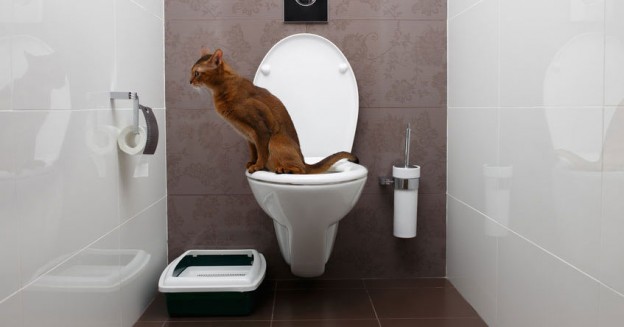The Consequences of Flushing Cat Poop Down Your Toilet - Safeguard Your Plumbing
The Consequences of Flushing Cat Poop Down Your Toilet - Safeguard Your Plumbing
Blog Article
How do you really feel in regards to Can You Flush Cat Poo or Litter Down the Toilet??

Introduction
As pet cat proprietors, it's important to be mindful of just how we throw away our feline buddies' waste. While it might seem hassle-free to purge pet cat poop down the commode, this practice can have damaging effects for both the setting and human health.
Environmental Impact
Flushing cat poop presents dangerous microorganisms and bloodsuckers into the water, presenting a substantial risk to marine communities. These pollutants can adversely affect aquatic life and compromise water high quality.
Health and wellness Risks
Along with ecological issues, purging pet cat waste can likewise present wellness dangers to people. Cat feces may include Toxoplasma gondii, a parasite that can create toxoplasmosis-- a possibly severe health problem, particularly for expectant females and people with damaged immune systems.
Alternatives to Flushing
Luckily, there are more secure and a lot more accountable methods to take care of pet cat poop. Consider the complying with choices:
1. Scoop and Dispose in Trash
The most usual approach of getting rid of cat poop is to scoop it into a naturally degradable bag and toss it in the trash. Make certain to use a committed litter scoop and get rid of the waste without delay.
2. Usage Biodegradable Litter
Go with biodegradable pet cat clutter made from products such as corn or wheat. These clutters are eco-friendly and can be securely disposed of in the garbage.
3. Hide in the Yard
If you have a lawn, think about burying cat waste in a marked location far from vegetable yards and water resources. Make sure to dig deep sufficient to avoid contamination of groundwater.
4. Set Up a Pet Waste Disposal System
Buy a pet waste disposal system specifically created for feline waste. These systems use enzymes to break down the waste, decreasing odor and environmental effect.
Verdict
Liable animal ownership extends past giving food and sanctuary-- it additionally includes proper waste monitoring. By avoiding flushing pet cat poop down the bathroom and going with different disposal techniques, we can lessen our environmental impact and protect human health.
Why Can’t I Flush Cat Poop?
It Spreads a Parasite
Cats are frequently infected with a parasite called toxoplasma gondii. The parasite causes an infection called toxoplasmosis. It is usually harmless to cats. The parasite only uses cat poop as a host for its eggs. Otherwise, the cat’s immune system usually keeps the infection at low enough levels to maintain its own health. But it does not stop the develop of eggs. These eggs are tiny and surprisingly tough. They may survive for a year before they begin to grow. But that’s the problem.
Our wastewater system is not designed to deal with toxoplasmosis eggs. Instead, most eggs will flush from your toilet into sewers and wastewater management plants. After the sewage is treated for many other harmful things in it, it is typically released into local rivers, lakes, or oceans. Here, the toxoplasmosis eggs can find new hosts, including starfish, crabs, otters, and many other wildlife. For many, this is a significant risk to their health. Toxoplasmosis can also end up infecting water sources that are important for agriculture, which means our deer, pigs, and sheep can get infected too.
Is There Risk to Humans?
There can be a risk to human life from flushing cat poop down the toilet. If you do so, the parasites from your cat’s poop can end up in shellfish, game animals, or livestock. If this meat is then served raw or undercooked, the people who eat it can get sick.
In fact, according to the CDC, 40 million people in the United States are infected with toxoplasma gondii. They get it from exposure to infected seafood, or from some kind of cat poop contamination, like drinking from a stream that is contaminated or touching anything that has come into contact with cat poop. That includes just cleaning a cat litter box.
Most people who get infected with these parasites will not develop any symptoms. However, for pregnant women or for those with compromised immune systems, the parasite can cause severe health problems.
How to Handle Cat Poop
The best way to handle cat poop is actually to clean the box more often. The eggs that the parasite sheds will not become active until one to five days after the cat poops. That means that if you clean daily, you’re much less likely to come into direct contact with infectious eggs.
That said, always dispose of cat poop in the garbage and not down the toilet. Wash your hands before and after you clean the litter box, and bring the bag of poop right outside to your garbage bins.
https://trenchlesssolutionsusa.com/why-cant-i-flush-cat-poop/

Do you like reading up on How to Dispose of Cat Poop and Litter Without Plastic Bags? Try leaving a short review directly below. We'd be interested to see your thoughts about this posting. We are looking forward to see you back again in the near future. Loved our post? Please share it. Let others locate it. Bless you for your time. Kindly check our site back soon.
At This Website Report this page